NCERT Solutions for Class 10 Maths Chapter 2 – Polynomials
Exercise 2.1 : Solutions of Questions on Page Number : 28
Q1 : The graphs of y = p(x) are given in following figure, for some polynomials p(x). Find the number of zeroes of p(x), in each case.
(i)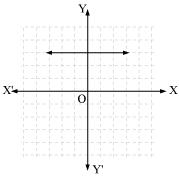
(ii)
(iii)
(iv)
(v)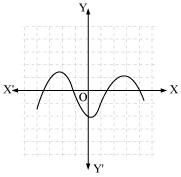
(vi)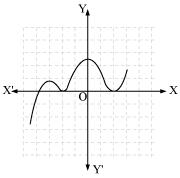
Answer :
(i) The number of zeroes is 0 as the graph does not cut the x-axis at any point.
(ii) The number of zeroes is 1 as the graph intersects the x-axis at only 1 point.
(iii) The number of zeroes is 3 as the graph intersects the x-axis at 3 points.
(iv) The number of zeroes is 2 as the graph intersects the x-axis at 2 points.
(v) The number of zeroes is 4 as the graph intersects the x-axis at 4 points.
(vi) The number of zeroes is 3 as the graph intersects the x-axis at 3 points.
NCERT Solutions for Class 10 Maths Chapter 2 – Polynomials
Exercise 2.2 : Solutions of Questions on Page Number : 33
Q1 : Find the zeroes of the following quadratic polynomials and verify the relationship between the zeroes and the coefficients.
![]()
![]()
![]()
![]()
![]()
![]()
Answer :
![]()
The value of![]() is zero when x – 4 = 0 or x + 2 = 0, i.e., when x = 4 or x = – 2
is zero when x – 4 = 0 or x + 2 = 0, i.e., when x = 4 or x = – 2
Therefore, the zeroes of![]() are 4 and – 2.
are 4 and – 2.
Sum of zeroes =![]()
Product of zeroes![]()
![]()
The value of 4s² – 4s + 1 is zero when 2s – 1 = 0, i.e.,![]()
Therefore, the zeroes of 4s² – 4s + 1 are![]() and
and![]() .
.
Sum of zeroes =
Product of zeroes![]()
![]()
The value of 6x2 – 3 – 7x is zero when 3x + 1 = 0 or 2x – 3 = 0, i.e.,![]() or
or![]()
Therefore, the zeroes of 6x2 – 3 – 7x are![]() .
.
Sum of zeroes =![]()
Product of zeroes =![]()

The value of 4u2 + 8u is zero when 4u = 0 or u + 2 = 0, i.e., u = 0 or u = – 2
Therefore, the zeroes of 4u2 + 8u are 0 and – 2.
Sum of zeroes =![]()
Product of zeroes =![]()

The value of t2 – 15 is zero when ![]() or , i.e., when
or , i.e., when
Q2 : Find a quadratic polynomial each with the given numbers as the sum and product of its zeroes respectively.
![]()
![]()
![]()
![]()
![]()
![]()
Answer :
![]()
Let the polynomial be![]() , and its zeroes be
, and its zeroes be ![]() and
and ![]() .
.
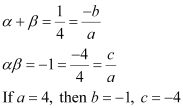
Therefore, the quadratic polynomial is 4x2 – x – 4.
![]()
Let the polynomial be ![]() , and its zeroes be
, and its zeroes be![]() and
and![]() .
.

Therefore, the quadratic polynomial is 3x2 – ![]() x+ 1.
x+ 1.
![]()
Let the polynomial be![]() , and its zeroes be
, and its zeroes be ![]() and
and![]() .
.
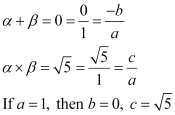
Therefore, the quadratic polynomial is ![]() .
.
![]() Let the polynomial be
Let the polynomial be![]() , and its zeroes be
, and its zeroes be![]() and
and![]() .
.
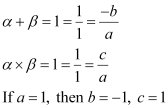
Therefore, the quadratic polynomial is x2 – 1+ 1.

Exercise 2.3 : Solutions of Questions on Page Number : 36
Q1 : Divide the polynomial p(x) by the polynomial g(x) and find the quotient and remainder in each of the following:
(i)![]()
(ii)![]()
(iii)![]()
Answer :

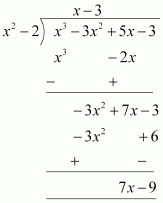
Quotient = x – 3
Remainder = 7x – 9

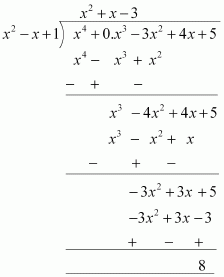
Quotient = x2 + x – 3
Remainder = 8


Quotient = – x2 – 2
Remainder = – 5x +10
Q2 : Check whether the first polynomial is a factor of the second polynomial by dividing the second polynomial by the first polynomial:
 Answer :
Answer :
![]()
![]() =
=![]()

Since the remainder is 0,
Hence,![]() is a factor of
is a factor of![]() .
.
![]()
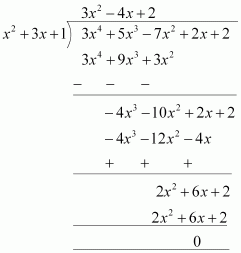
Since the remainder is 0,
Hence,![]() is a factor of
is a factor of![]() .
.
![]()

Since the remainder ,
Hence,![]() is not a factor of
is not a factor of![]()
Q3 : Obtain all other zeroes of![]() , if two of its zeroes are
, if two of its zeroes are![]() .
.
Answer :
![]() Since the two zeroes are
Since the two zeroes are ![]() ,
,
is a factor of ![]() .
.
Therefore, we divide the given polynomial by![]() .
.
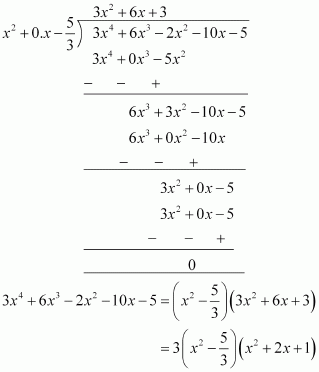
We factorize![]()
![]()
Therefore, its zero is given by x + 1 = 0
x = – 1
As it has the term![]() , therefore, there will be 2 zeroes at x = – 1.
, therefore, there will be 2 zeroes at x = – 1.
Hence, the zeroes of the given polynomial are![]() , – 1 and – 1.
, – 1 and – 1.
Q4 : On dividing![]() by a polynomial g(x), the quotient and remainder were x – 2 and – 2x + 4, respectively. Find g(x).
by a polynomial g(x), the quotient and remainder were x – 2 and – 2x + 4, respectively. Find g(x).
Answer :
![]() g(x) = ? (Divisor)
g(x) = ? (Divisor)
Quotient = (x – 2)
Remainder = ( – 2x + 4)
Dividend = Divisor × Quotient + Remainder

g(x) is the quotient when we divide![]() by
by![]()
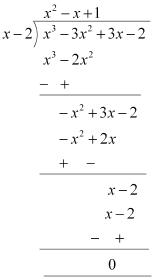
![]()
Q5 : Give examples of polynomial p(x), g(x), q(x) and r(x), which satisfy the division algorithm and
(i) deg p(x) = deg q(x)
(ii) deg q(x) = deg r(x)
(iii) deg r(x) = 0
Answer :
According to the division algorithm, if p(x) and g(x) are two polynomials with
g(x) ≠ 0, then we can find polynomials q(x) and r(x) such that
p(x) = g(x) × q(x) + r(x),
where r(x) = 0 or degree of r(x) < degree of g(x)
Degree of a polynomial is the highest power of the variable in the polynomial.
(i) deg p(x) = deg q(x)
Degree of quotient will be equal to degree of dividend when divisor is constant ( i.e., when any polynomial is divided by a constant).
Let us assume the division of![]() by 2.
by 2.
Here, p(x) =![]()
g(x) = 2
q(x) =![]() and r(x) = 0
and r(x) = 0
Degree of p(x) and q(x) is the same i.e., 2.
Checking for division algorithm,
p(x) = g(x) × q(x) + r(x)
![]() = 2(
= 2(![]() )
)
=![]() Thus, the division algorithm is satisfied.
Thus, the division algorithm is satisfied.
(ii) deg q(x) = deg r(x)
Let us assume the division of x3+ x by x2,
Here, p(x) = x3 + x
g(x) = x2
q(x) = x and r(x) = x
Clearly, the degree of q(x) and r(x) is the same i.e., 1.
Checking for division algorithm,
p(x) = g(x) × q(x) + r(x)
x3 + x = (x2 ) × x + x
x3 + x = x3 + x
Thus, the division algorithm is satisfied.
(iii)deg r(x) = 0
Degree of remainder will be 0 when remainder comes to a constant.
Let us assume the division of x3+ 1by x2.
Here, p(x) = x3 + 1
g(x) = x2
q(x) = x and r(x) = 1
Clearly, the degree of r(x) is 0.
Checking for division algorithm,
p(x) = g(x) × q(x) + r(x)
x3 + 1 = (x2 ) × x + 1
x3 + 1 = x3 + 1
Thus, the division algorithm is satisfied.
Exercise 2.4 : Solutions of Questions on Page Number : 37
Q 1 : Verify that the numbers given alongside of the cubic polynomials below are their zeroes. Also verify the relationship between the zeroes and the coefficients in each case:
 Answer :
Answer :
(i)![]()
![]()
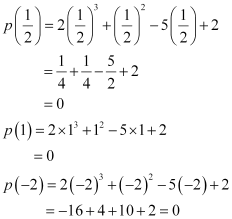
Therefore,![]() , 1, and – 2 are the zeroes of the given polynomial.
, 1, and – 2 are the zeroes of the given polynomial.
Comparing the given polynomial with![]() , we obtain a = 2, b = 1, c = – 5, d = 2
, we obtain a = 2, b = 1, c = – 5, d = 2
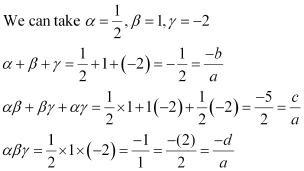
Therefore, the relationship between the zeroes and the coefficients is verified.
(ii)![]()
![]()
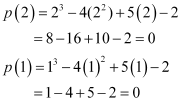
Therefore, 2, 1, 1 are the zeroes of the given polynomial.
Comparing the given polynomial with![]() , we obtain a = 1, b = – 4, c = 5, d = – 2.
, we obtain a = 1, b = – 4, c = 5, d = – 2.
Verification of the relationship between zeroes and coefficient of the given polynomial
![]()
Multiplication of zeroes taking two at a time = (2)(1) + (1)(1) + (2)(1) =2 + 1 + 2 = 5![]()
Multiplication of zeroes = 2 × 1 × 1 = 2![]()
Hence, the relationship between the zeroes and the coefficients is verified.
Q2 : Find a cubic polynomial with the sum, sum of the product of its zeroes taken two at a time, and the product of its zeroes as 2, – 7, – 14 respectively.
Answer :
Let the polynomial be ![]() and the zeroes be
and the zeroes be ![]() .
.
It is given that
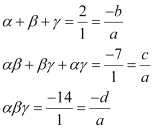
If a = 1, then b = – 2, c = – 7, d = 14
Hence, the polynomial is ![]() .
.
Q3 : If the zeroes of polynomial![]() are
are![]() , find a and b.
, find a and b.
Answer :
![]() Zeroes are a – b, a + a + b
Zeroes are a – b, a + a + b
Comparing the given polynomial with![]() , we obtain
, we obtain
p = 1, q = – 3, r = 1, t = 1
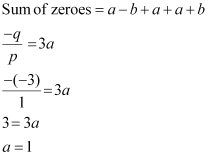
The zeroes are ![]() .
.
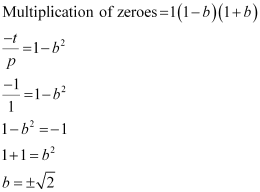
Hence, a = 1 and b =![]() or-
or-![]() .
.
Q4 : It two zeroes of the polynomial![]() are
are![]() , find other zeroes.
, find other zeroes.
Answer :
Given that 2 + ![]() and 2-
and 2-![]() are zeroes of the given polynomial.
are zeroes of the given polynomial.
Therefore,![]() = x2 + 4 – 4x – 3
= x2 + 4 – 4x – 3
= x2 – 4x + 1 is a factor of the given polynomial
For finding the remaining zeroes of the given polynomial, we will find the quotient by dividing![]() by x2 – 4x + 1.
by x2 – 4x + 1.

Clearly,![]() =
=![]()
It can be observed that![]() is also a factor of the given polynomial.
is also a factor of the given polynomial.
And ![]() =
=![]()
Therefore, the value of the polynomial is also zero when![]() or
or![]()
Or x = 7 or – 5
Hence, 7 and – 5 are also zeroes of this polynomial.
Q5 : If the polynomial![]() is divided by another polynomial
is divided by another polynomial![]() , the remainder comes out to be x + a, find k and a.
, the remainder comes out to be x + a, find k and a.
Answer :
By division algorithm,
Dividend = Divisor × Quotient + Remainder
Dividend – Remainder = Divisor × Quotient
![]()
will be perfectly divisible by![]() .
.
Let us divide ![]() by
by![]()
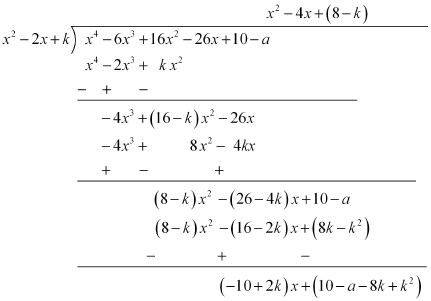
It can be observed that![]() will be 0.
will be 0.
Therefore,![]() = 0 and
= 0 and![]() = 0
= 0
For![]() = 0,
= 0,
2 k =10
And thus, k = 5
For ![]() = 0
= 0
10 – a – 8 × 5 + 25 = 0
10 – a – 40 + 25 = 0
– 5 – a = 0
Therefore, a = – 5
Hence, k = 5 and a = – 5
NCERT Solutions for Class 10 Maths All Chapters
- Chapter 1 – Real Numbers
- Chapter 2 – Polynomials
- Chapter 3 – Pair of Linear Equations in Two Variables
- Chapter 4 – Quadratic Equations
- Chapter 5 – Arithmetic Progressions
- Chapter 6 – Triangles
- Chapter 7 – Coordinate Geometry
- Chapter 8 – Introduction to Trigonometry
- Chapter 9 – Some Applications of Trigonometry
- Chapter 10 – Circles
- Chapter 11 – Constructions
- Chapter 12 – Areas Related to Circles
- Chapter 13 – Surface Areas and Volumes
- Chapter 14 – Statistics
- Chapter 15 – Probability